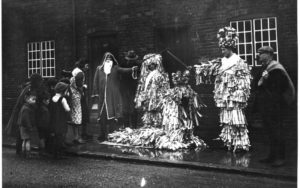
Mummers plays, also known as Mumming play, is a folk play, traditional dramatic entertainment performed usually by amateurs. This form of entertainment is popular throughout Europe in different forms and is still performed in few villages. It is believed that the play has connection with primitive ceremonies held to signify important stages of agricultural year. The name has been derived by combining two words, mumble and mute.
The word is believed to have come from the Greek word Mommo, which means mask. In fourteenth century wearing these masks were popular in royal functions. This practice was called Momerie. However, when this fashion spread into the street it caused many problems like revelry by night and since the revellers wore masks, it gave plenty of opportunity to crime due to which some towns banned Mummery.
Mummers
Mummers were masked people who used to parade on the streets of Europe during winter festival and enter the houses to play dice and dance in silence. Mummers refers to those who are mumming and this was not involved in plays always. These plays were formerly performed in much of English-speaking parts of the world. There are few surviving teams of traditional mummers still in England and Ireland.
The characters were introduced in a series of short speeches or they introduced themselves in the course of action of the play. The principle characters and the chief opponent were more or less common. There was a Quack Doctor who used to come in the end to bring back dead man to life. The mumming groups often wore face-obscuring hats or different types of masks and headgears. Some mummers even painted their faces.
Antiquity
Mumming was a way of raising money and so, the play was taken mostly round big houses. Mumming is said to be part of society at least since 1296. Between 13th and 16th century Momerie was the popular amusement. However, the first textual appearance of mummers play, Doctor, is said to be in an updated chapbook of “Alexander and the king of Egypt” which was published in Newcastle Upon Tyne by John White. This happened between 1746 and 1769.
The basic narrative framework is the story of St. George. Although the plot remained essentially the same, different communities modified it to their own use. The main intention was to show the struggle between good and evil. The play had originally been part of spring festivals where people welcome the spring season and say good bye to winter. However, the plays were often performed during Christmas time.
The traditional mummers plays had stopped with the onset of First World War but many groups revived in the second half of the twentieth century mostly by dance enthusiasts and folk music. After that these players were taken around public houses and inns around Christmas time and the begging was done for some charity often and not for the mummers themselves. Mummers were actually glorified travelling beggars who moved from one place to another performing their play for money and food.
Different elements of the play formed through varied sources. Usually the rural community or during early days, plays were handled down by word of mouth. However, many performers were killed during the World War and then renewed interest in folk customs headed the revival of mummers play in the second half of the twentieth century. Depending on the locality and the size of the group, mumming varied on different aspects.
Costume
Dress of the mummers seemed relatively unimportant because the performers were usually poor people. Also, during that time the play was performed by male actors only, they used to get dressed in woman’s attire too for the performance.
Mummers Plays were usually laid in black and white and the tone used to be mostly humorous. So, it used to be cheering your hero and booing the villain. Moreover, Mumming plays represented authentic folk tradition having strong roots in rituals and carnival. Although performances were pretty common in mid-nineteenth century, there are few performances nowadays. The plot combined music, dance and sword fighting involving death and revival of characters.
However, mumming finally died a natural death when the societies changed so much that ordinary people just abandoned the practice.